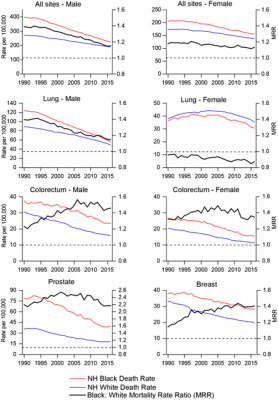Press Releases
To continue this progress, we need to expand access to high-quality cancer prevention, early detection, and treatment for all Americans.
Although African Americans still bear a disproportionate share of the cancer burden, a new report finds the black-white gap has closed considerably over the past several decades. Cancer Statistics for African Americans and its companion publication Cancer Facts & Figures for African Americans, published every three years by American Cancer Society investigators, reports that the overall cancer death rate is dropping faster in blacks than in whites, largely driven by greater declines for three of the four most common cancers.
The report appears early online in CA: A Cancer Journal for Clinicians, a peer-reviewed journal of the American Cancer Society.
The black-white disparity is narrowing for lung, prostate, and colorectal cancer and has stabilized since 2010 for breast cancer. As a result, the excess risk of overall cancer death in blacks compared with whites dropped from 47% in 1990 to 19% in 2016 in men and from 19% to 13% in women. Progress is even greater in men under 50 and women 70 and over, among whom the black-white cancer disparity has been nearly eliminated.
Despite the declining disparity, African Americans have the highest death rate and the lowest survival rate of any racial or ethnic group for most cancers in the United States. Socioeconomic status (SES), which is strongly correlated with race in this country, is the most critical factor driving these racial inequalities.
To monitor progress in reducing those inequalities, every three years the American Cancer Society provides the most recent data on cancer incidence, mortality, survival, screening, and risk factors, as well as the estimated numbers of new cancer cases and deaths in the current year, using data from the National Cancer Institute, the North American Association of Central Cancer Registries, and the National Center for Health Statistics.
In 2019, approximately 202,260 new cancer cases and 73,030 cancer deaths are expected to occur among blacks in the United States. Prostate cancer is the most commonly diagnosed cancer in black men, and breast cancer is the most commonly diagnosed in black women, each accounting for nearly one-third of cancers diagnosed in each sex. Cancers of the lung and colorectum are the second and third most common cancers, respectively, in both black men and women.
During 2006 through 2015, the overall cancer incidence rate also decreased faster in black men than in white men (2.4% vs 1.7% per year), largely due to more rapid declines in lung cancer. The incidence rate was stable in black women (compared with a slight increase in white women), reflecting increasing rates for breast, endometrial, and pancreatic cancer offsetting by declining trends for lung and colorectal cancer.
Lung cancer is the leading cause of cancer death among both black men (25% of deaths) and black women (20% of deaths), followed by breast cancer in women (18%) and prostate cancer in men (15%). Colorectal cancer is expected to be the third-leading cause of cancer death for black men and women.
Overall cancer death rates were lower in blacks than in whites during the early 1950s; however, rates increased sharply in blacks from 1950 through 1990 and have remained higher compared with whites since the 1960s. Cancer death rates peaked in black men and women in the early 1990s and have subsequently declined, with a steeper decline in men. That progress translates into the avoidance of more than 462,000 cancer deaths over the past 25 years.
The narrowing of black-white disparities is striking in some age groups. Among men ages 40 to 49, the cancer death rate was 102% higher in blacks than in whites during 1990-1991 but had shrunk to just 17% higher during 2015-2016. Among women ages 40 to 49, the overall disparity narrowed from 44% in 1990-1991 to 30% in 2015-2016. And among black women ages 80 to 89, the cancer mortality rate was 8% higher than whites during 2002-2003, but 3% lower in 2015-2016.
“Seeing the substantial progress made over the past several decades in reducing black-white disparities in cancer mortality is incredibly gratifying,” said Len Lichtenfeld, M.D., interim chief medical officer for the American Cancer Society. “This progress is driven in large part by drops in the lung cancer death rate driven by more rapid decreases in smoking over the past 40 years in blacks than in whites. To continue this progress, we need to expand access to high-quality cancer prevention, early detection, and treatment for all Americans.”
Article: Cancer Statistics for African Americans, 2019, CA Cancer J Clin 2019; doi: 10.3322/caac.21555
